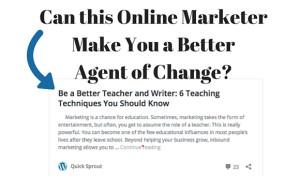Conflict resolution and human development people could learn a lot from business marketers. We have a message and tools that address critical challenges for human beings.
We should learn from the best practices of those who are successfully using modern tools of communication to influence others. At this time, those are online business marketers.
True, online marketing is often shallow and manipulative. Yet, for better or for worse, its success in influencing people means we have to understand it. Amidst all the hype, we can learn valuable insights about how to communicate.
I follow a small number of online marketers who meet all of the following criteria:
1) They have a track record of success in reaching others in their business efforts;
2) They are in the school of marketing thought and practice known as inbound marketing, which says that the best way to be a successful marketer is to truly meet genuine needs of your clients. If you do this, and use effective strategies to become visible and interact with them, clients will come, say the inbound marketers.
3) They demonstrate a commitment not just to making money but also to actively doing what they can to make the world a better place. I especially respect those personally involved in philanthropic efforts.
Among these is Neil Patel, who blogs at www.quicksprout.com. He’s wonderfully strategic, pays great attention to detail, and he works hard at communication. His writing is simple, clear, and accessible, with that odd blend of humility and self-confidence that characterizes many successful agents of change. I have no relationship to him, financial or otherwise.
Here’s a recent blog post:
Be a Better Teacher and Writer: 6 Teaching Techniques You Should Know
If you are involved in any kind of effort to educate or bring change to human beings, read it! It’s one of the better summaries I’ve seen on communicating for impact. I immediately changed the title of a recent blog post after reading his second point.
If you are thinking of using the web to reach people, you might sign up for Patel’s site and pay attention to the stuff he sends. He has studied every step of the journey of interaction with people and refined what he does to increase the odds that in the end you will decide that he’s got what you need and will buy from him. You can learn a lot by observing how he seeks to win your trust.
OK, he’s selling services, to income-generating businesses. His strategies are designed to reach people deeply motivated by desire. That’s different than communicating for social change or peace.
Peace, we know, is not a commodity. It can’t be marketed. It’s a gift that follows good choices and habits of mindful living.
But. Desire is certainly at the heart of most human choices, and that is not all bad. And there is no denying that misdirected desire is a great enemy of peace. So we better learn how to work in the presence of this powerful drive and, when we can, harness its energy for good.
I get useful ideas every time I read Patel or other web marketers like Perry Marshall, Michael Stelzner, and Pat Flynn and I think change agents everywhere can learn from people like them. But there is an overwhelming amount of stuff out there. We need to help each other separate the wheat from the chaff.
I’d love to hear your thoughts about:
- To what extent can we adapt highly refined strategies from people like Patel across into efforts for peace, justice, human development and care for the environment?
- What strategies and resources from the marketing world have you found useful?
- Where have you been disappointed by things you’ve tried to apply from marketers?



Great! I’d love to read your comments about using Facebook and Twitter to promote peace.
The mantra of online marketers is “market to pain”, meaning, address real difficulties and needs of those you are marketing to. I would be interested to hear: 1) what you consider to be the pain points of those you are trying to reach; 2) what, specifically, you provide that addresses those pain points; and 3) how in your online presence you go about making a connection in the minds of those you are trying to reach between their pain points and what you offer?
I’ve been interested in this topic for some time. I’ve actually written about using Facebook and Twitter etc. to promote peace. Indeed I reflected on the fact that most of my Twitter followers are online marketers. They appear to be interested in anything that’s online. A few may even be interested in the content of my blog regionalconflictinsights.org. I will certainly follow your advice and read Patel’s blog. Thanks.
Hi Ron, thanks for posting this, lots of good guidance. Wanted to explore one idea you shared: “Peace, we know, is not a commodity. It can’t be marketed. It’s a gift that follows good choices and habits of mindful living.”
Peace may not be a commodity in terms of ‘a thing to purchase and get in the mail.’ But it is a ‘real thing’–it is an experience, a framework, a mindset, etc. Plenty of other things that are not ‘commodities’ are being successfully marketed online as a means to achieving another non-physical entity: life coaching as a means to achieving happiness; job search coaching as a means to achieving a promotion or a new career; parent coaching as a means to achieving harmonious family life. . .
I think it’s high time we conflict resolution and peace ed folks start perceiving ourselves and marketing ourselves as ‘peace coaches’ within particular niche markets. Some have begun doing so: google peace coaching and you’ll find a few examples. And there’s plenty of room in this space, and like you said, the right inbound marketing guidance can help significantly.